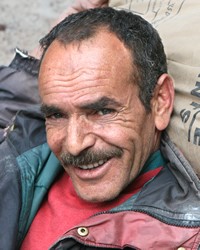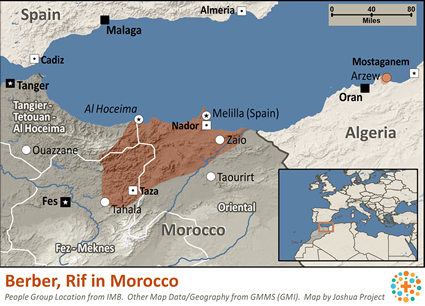The Northern Shilha are also collectively known as Rif Berbers. The word "rif" is an Arabic word meaning "the edge of cultivated area." Their homeland is the Rif Mountains. This inhospitable land, located in Morocco and Algeria, is a combination of deserts, mountains and rolling fields. It is bordered by two rivers and 145 miles of coastline.
Rif Berbers are made up of 19 tribes: five in the west along the Mediterranean coast, seven in the center, five in the east and two in the southeastern desert area.
Despite the rugged environment, Rif Berbers remain bound by strong family traditions. Their farming is done mostly by hand, providing a meager crop at best. Influenced by a Mediterranean climate, the winters are mild and the summers hot and dry. Along the coast, it is humid in the summer months.
In contrast to the Southern and Central Shilha, raising livestock plays only a secondary role in the lives of Rif Berbers. They grow some sorgum (grain) for feed, but the fig and olive trees that cover the mountain slopes make up their principal resources. Poor crop yields are a concern. Overpopulation and poverty are big problems among the Rif Berbers. Incomes are supplemented through job opportunities in major cities of Europe. Such jobs lure up to one-third of the male population for most of the year.
In rural Rif Berber communities, the effects of modernization are scarce, despite government projects to aid farm production. Rif Berbers often reject these efforts as being an intrusion upon their culture and traditions.
Rif Berber houses are usually built of stone and have flat roofs. Some of the poorer people live in wood huts plastered with mud. For defense purposes they build their houses on ridges or other such locations, at least 300 meters from the nearest neighbor.
Rif Berber women wear long, colorful dresses and head scarves. The men wear the traditional djellaba cloak, which is made of wool or cotton with wide sleeves and a hood. They also wear turbans, which are distinctive and unique to each tribe. Younger men often wear western style clothing.
The Rif Berbers follow a traditional Muslim, male-dominated family structure. When the man dies, each son sets up his own household, and the cycle continues. Education is strictly a male privilege, but they don't prioritize it. If a family has many sons, they may send their third and fourth sons to an Islamic school.
The Rif Berbers are nearly all Muslim; however, their religious practices are based more on traditions and the decisions of the community judges than on the Koran. Their societies are organized around two main systems: Islam and the tribe. However, there are many differences between urban and rural societies. In urban areas, orthodox Islam prevails, whereas, in rural societies, ancient beliefs and customs are intermingled with their Muslim faith.
Although the Rif Berbers have been one of the most responsive Berber groups to Bible correspondence courses offered by radio, there has been no known Protestant witness living among them for at least a century. There has been some progress among them in urban centers.
Rif Berbers have not taken advantage of the educational opportunities available to them, apparently not realizing their importance. Modern farming methods are desperately needed to aid farm production in the arid soil.
Although the New Testament and a Christian witness are accessible to them, a majority of the Rif Berbers have not yet heard the gospel.
Ask the Lord to call people who are willing to go to Morocco and Algeria to share Christ with the Rif Berbers.
Ask God to strengthen, encourage and protect the small number of Rif Berber Christians. May they establish strong fellowships.
Pray for Rif Berber elders to have dreams and visions of the risen, victorious Christ.
Ask the Lord to raise a strong local church among Rif Berbers.
Scripture Prayers for the Berber, Rif in Morocco.
| Profile Source: Joshua Project |


























